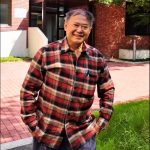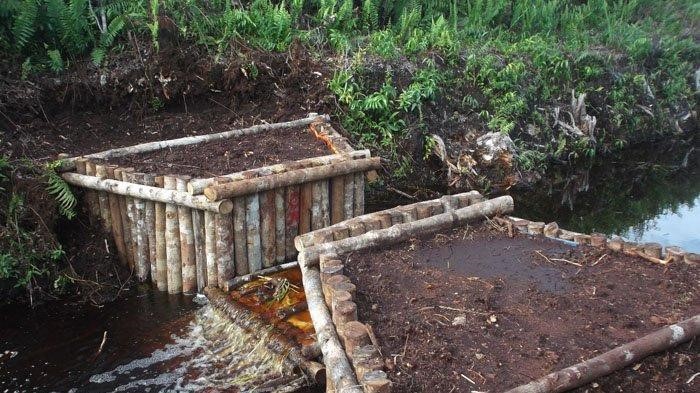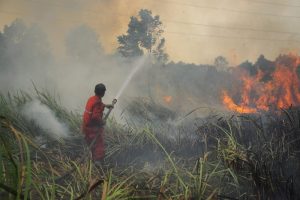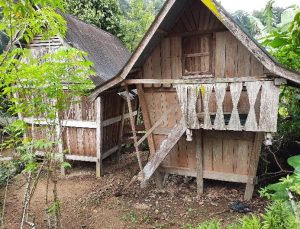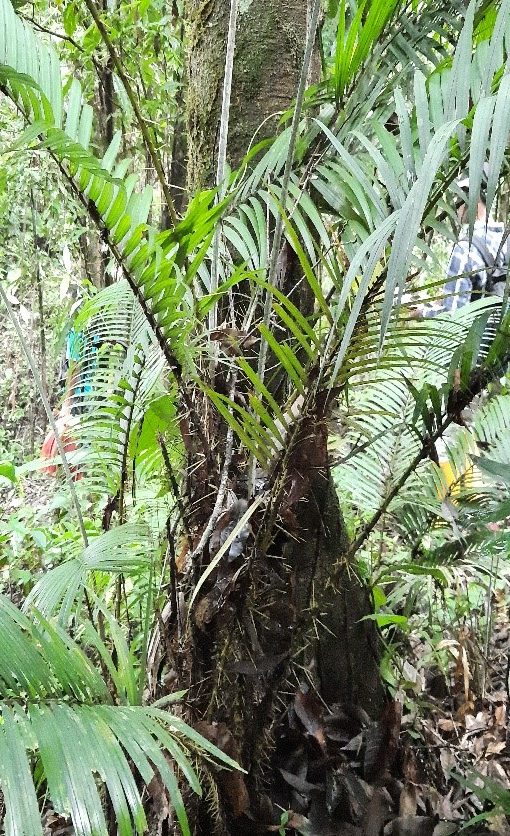Herman Hidayat
VISITOR’S VOICE
Interview with Herman Hidayat »
Sustainable peatland management: Critical for reducing global warming
Please tell us about your research.
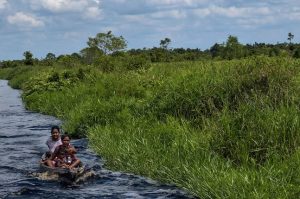
My main areas of research are in forest policy and political ecology, and Peat Swamp land management. I and our group at the National Research and Innovation Agency of Indonesia (BRIN) carried out fieldwork on peatland management from 2017-2019. The first set of fieldwork observed and studied the role of various stakeholders involved in peatland management in Pulang Pisau District (2017) and Kapuas District (2018) in Central Kalimantan. The second set of fieldwork focused on the participation of local people in peatland management (see Figs. 1-2). These research findings aimed to provide recommendations to the government, through Bappenas (Badan Perencanaan dan Pembangunan Nasional/Ministry of National Agency of Planning and Development), to address the disastrous forest fires that occurred in 2015 (Fig. 3). These fires were one of Indonesia’s biggest natural disasters and they created large amounts of CO2 emissions, inviting concern and criticism from across the world.
How many research themes do you have?
In 2022, we had two research themes. The first theme is social forestry, particularly the partnerships between private companies and local people in village social forestry programs. Fieldwork for this research was conducted in Segah Subdistrict, Berau District, East Kalimantan, in May 2022. The second theme is the customary rights of indigenous people in managing their forests.[1] We conducted fieldwork for this research in Rantau Kermas, Jangkat Subdistrict, Merangin District, Jambi Province in June 2022 (Fig. 4). Both topics are necessary to fully understand the role of indigenous people, NGOS (such as WWF, Jakalahari, and Warsi), and private companies in managing forests and non-timber products (NTFPs), such as rattan (Figure 5) and medicinal and other plants.
These themes also provide insights into the utilization, production, and distribution of NTFPs in economic, social, and ecological spheres.
Ultimately, we want to assess the national social forestry program, to monitor and evaluate the extent of policy implementation in the field and its strengths and weaknesses. Based on temporary findings, its strength is the ‘’synergetic” cooperation among government institutions and other stakeholders (NGOs, academics, local people, etc.). Meanwhile, one weakness is a lack of cooperation among multiple stakeholders to provide sufficient credit and training in management, human development, production, and marketing. From this perspective, we can see that the focus when implementing social forestry should be supporting local people. Our current research of the social forestry program is very relevant to working hand in hand with peatland management programs at the village (Desa), subdistrict (Kecamatan), and provincial level to mitigate poverty and ensure a sustainable future.
Why do you find your research topic interesting?
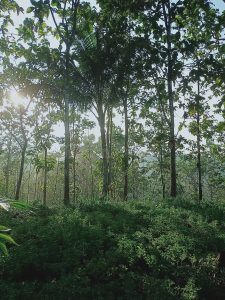
Social Forestry is a national program to economically, socially, and ecologically empower local people, especially those who live in and beside forest areas (Fig. 6). Local people and other stakeholders participate in conservation programs to sustainably manage forests. Since its launch in 2016, the program has designated 12.5 million hectares of forest as social forestry areas. According to the registered National Statistics of 2021, ten percent of poor people, who mainly live in villages in or near forest areas (25-30 million people), are unable to manage forest resources. The economic potential of forest resources accessed through social forestry schemes (such as Village forests (Hutan Desa), Community forestry (Hutan Kemasyarakatan), Community forest plantations (Hutan Tanaman Rakyat), Customary forests (Hutan Adat), and Forest Partnerships (Hutan Kemitraan), is significant to reducing poverty. During 2011-2016, 2.5 million hectares were designated for social forestry from the total area of 12.7 million hectares. One main challenge to implementing social forestry is the process of re-centralization that is now taking place due to law 23/2014. The law shifts the institutional structure from the district to the provincial level with the creation of a Forest Management Unit (FMU). It also realigns the bureaucratic network, drawing out the process so that the very final decision about a social forestry proposal rests in the hands of the central government, specifically the Ministry of Environment and Forestry’s Directorate General of Social Forestry, in Jakarta (Fisher, M.R., et al. 2018: 350).
How did you get started in your research and how did you come to focus on your current research?
The research agenda began by observing the real conditions of local people who live in areas bordering forests, who amount to more than 10 percent of Indonesia’s population. We adopted the current research themes to become more aware, to study, educate, facilitate, and to empower local people for their economic, social, and ecological advancement, because their performance is significant to the whole of Indonesia.
Have you had any difficulties in putting together the results of your research into a research paper or book?
Yes, frankly speaking I have found it difficult to put the results of my research into a research policy paper, both domestically and internationally, and to produce a book. This is related to insufficient data due to lack of time in the research field, insufficient funding, insufficient budget allocations for payments in international journals, and lack of appropriate methodologies.
Can you share with us an episode about any influential people, things, and places you have encountered whilst doing your research?
I have interviewed many impressive people while conducting fieldwork, including the heads of villages, traders of forest resources, businessmen, local people, and NGO workers. I have listened to their experiences in managing forest resources and distributing forest products to district and provincial trading markets. In this sense, social forestry in peatland areas has encouraged me to strive to implement wisdom and to integrate idealism and action research. If this can be realized, programs that target economic, social and ecological empowerment of local people can mitigate global warming due to climate change.
Which books or people have influenced you?
Relating to peatland and social forestry management, books that have influenced me include Gambut dan Pengetahuan Ekologi Tradisional (edited by Robert Siburian), Tropical Peatland Eco-Management (by Mitsuru Osaki et al.), and Catastrophe and Regeneration in Indonesia’s Peatlands (by Kosuke Mizuno et al.). Social forestry books and articles by Ari Rakatama et al., M.R. Fisher et al., and Hans Nicholas Jong have been influential as well (see references).
What is your ideal image of a researcher?
Research is a profession. To become a professional researcher, a person should master concepts, theories, and techniques of research into a methodological framework. To master a methodological framework, a researcher should graduate from a doctorate program in a university. Following this, a visiting scholarship can help a researcher establish partnerships and extend networks with a range of colleagues and home scholars. Researchers may apply to some research institutes to help them publish their research and eventually publish a book and articles in domestic and international journals. The Indonesian novelist and essayist Pramudya Ananta Toer said in his a famous novel Bumi Manusia (1980), “publishing a book is an eternal work, as it will be read and it is understood to become a social transformation for young generations in the future.”
What books can you recommend to a younger people?
To read widely enhances the spirit and inspires you to write articles and books. Certainly, if you wish to be a professional scientist, you must practice disciplined studies to extend your views and perspectives, for instance in the social sciences, natural sciences, human sciences, applied technology, and information technology. To expand the human science perspective, I recommend, among others, Catastrophe and Regeneration in Indonesia’s Peatland by Kosuke Mizuno et al., Climate Change, Disaster Risks, and Human Security by Juan M. Pulhin et al., and Earthly Politics: Local and Global in Environmental Governance by Sheila Jassanoff.
What ambitions do you have for the future?
I aim to be a real scientist of a specific discipline. I hope to publish in international and domestic books and journals, to contribute to the scientific discourse, to educate and socialize scientific transformation for future young generations. As you know, the destiny of every nation depends not only on their spirit, but also mastering science, technology, economics, and military science.
(October 2022)
Note
[1] For further explanation, see Hidayat, H. 2018. “Forests, Law and Customary Rights in Indonesia,” in Asia Pacific Viewpoint Journal. Number 59 (3): 293-308.
References
Ananta Toer, Pramudya. 1980. Bumi Manusia. Jakarta: Gramedia Press.
Fisher, M.R., et al. 2018. “Assessing the New Social Forestry Project in Indonesia: Recognition, Livelihood, and Conservation,” International Forestry Review Journal, Vol. 20 (3).
Hidayat, Herman. 2016. Forest Resources Management in Indonesia: A Political Ecology Approach. Singapore: Springer Press.
Hidayat, Herman. 2018. Sustainable Plantation Forestry: Problems, Challenges and Solutions. Singapore: Springer Press.
Hidayat, Herman. 2018. “Forests, Law and Customary Rights in Indonesia: Implications of a Decision of the Indonesian Court in 2012,” Asia Pacific Viewpoint Journal, Number 59 (3): 293-308.
Hidayat, Herman, et al. 2022. “Contribution of Sumalindo Company to Local People: Livelihood, Forest Conservation Program and Climate Change Mitigation”, Journal of Environmental Science and Engineering, Volume 11, Number 4, July-August, pp. 111-124.
Jassanoff, Sheila. 2004. Earthly Politics: Local and Global in Environmental Governance. USA: MIT Press.
Mizuno, Kosuke, et al. 2016. Catastrophe and Regeneration in Indonesia’s Peatlands: Ecology, Economy and Society. Singapore: NUS Press in Association with Kyoto University Press, Japan.
Nicholas Jong, Hans. 2022. “Community Control of Forests hasn’t Slowed Deforestation, Indonesia Study Finds,” Indonesian Forests, 4 January.
Osaki, Mitsuru, et al. 2021. Tropical Peatland Eco-Management. Singapore: Springer Press.
Rakatama, Ari, et al. 2020. “Reviewing Social Forestry in Indonesia: Opportunities and Challenges,” Forest Policy and Economics Journal, Vol. 11, February.
Pulhin, Juan, et al. 2021. Climate Change, Disaster Risks, and Human Security. Singapore: Springer Press.
Siburian, Robert (ed). 2020. Gambut dan Pengetahuan Ekologi Tradisional: Kebijakan, Degradasi, dan Restorasi. Jakarta: Yayasan Pustaka Obor Press.
Herman Hidayat is a Visiting Research Scholar of CSEAS
from September 2022 – November 2022
